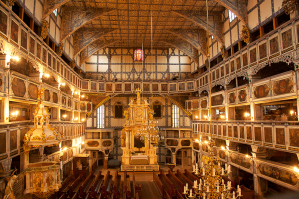The Thirty Years' War in
Europe ended with the
Treaty of Westphalia (1648), which upheld the principle of
cuius regio eius religio( the faith professed by the ruler was obligatory for his subjects). At that time
Silesia was a part of the
Catholic Habsburg monarchy.
 |
| Wooden Church in Swidnica, Poland |
In most of the province
Protestants were persecuted and deprived of the right and possibility to practice their faith. Through the activity of the
Lutheran king of Sweden, the Emperor finally allowed (1651-52) the erection of
three churches, hereafter known as the
Churches of Peace, in
Silesian principalities under direct
Habsburg rule in
Glogow (Glogau), which ceased to exist in the 18th century,
Jawor (Jauer), and Swidnica (Schweidnitz) in the south-west part of present-day
Poland. The churches had to be built exclusively of
perishable materials (wood and clay), located
outside city walls,
and built in a limited period of time. These restrictions, together
with the need to provide adequate space for large crowds of worshippers,
forced the
architect, Albrecht von Sabisch (1610-88), a prominent
master-builder and fortification designer active in
Wroclaw, to implement pioneering
constructional and architectural solutions of a scale and complexity unknown ever before or since in
wooden architecture. The timber-framed structures of enormous scale and complexity were assembled.
- The first permit was given to Glogow
(1651) and the site was located 300m outside the city walls. Building
started quickly and the first service was held in October 1652, but the
church was destroyed by a violent storm in the summer of 1654. A new church was built the following year, but this burnt down in 1758 and was then replaced by a brick building.
- Church of Jawor. The permit for the other two churches was given in 1652; the Church of Jawor
was built in 1654-55. The church itself is of a large size, he walls
and ceiling are totally covered with white and blue ornaments. The floor
of the church in Jawor is completely filled with rows and rows of
wooden benches: it has room for 6000 people. There are no less than 143
biblical scenes painted on the walls, and an ornate high altar. A
wonderfully preserved and original site, and still in use.
- Church of Swidnica.
 |
| Church of Peace at Jawor, Poland |
In Swidnica
a temporary structure (Gotteshüttlein, God's Hut) was built in 1652 and
the actual construction was able to take place in 1656-57, thanks to
the donation of Count Hans Heinrich von Hochberg and support from the Lutheran magistrate of Swidnica.
A new sacristy was erected in 1695 and private pews were built by noble
families in the early 18th century. Several auxiliary buildings were
added to the ensemble, including the residences of the pastor and the
vicars, a Latin school, and a German school. During the Silesian War, Swidnica was under siege on several occasions, and the hostilities resulted in the destruction of the sacristy and structural damage to the northern wall. All the damage was repaired by 1763.


No comments:
Post a Comment